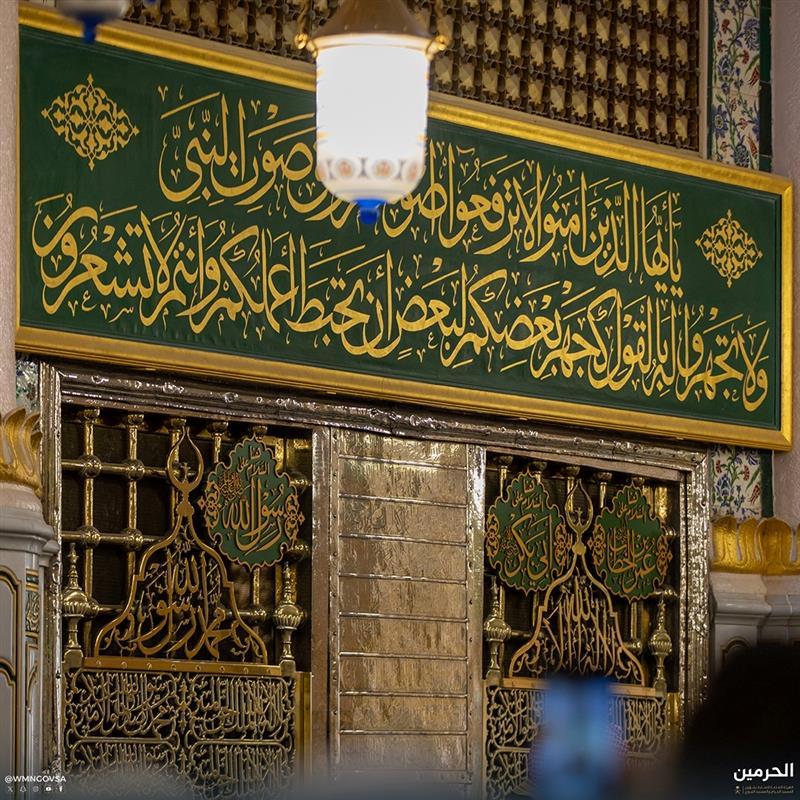The Prophet's Chamber

The Blessed Chamber is the house of the Prophet Muhammad (may Allah's salah and salam be upon him) where he lived with his wife, ‘Aishah bint Abi Bakr (may Allah be pleased with them). This chamber holds great significance as it contains the grave of the Prophet Muhammad (may Allah's salah and salam be upon him) and his companions Abu Bakr Al-Siddiq and Umar ibn ul-Khattab (may Allah be pleased with them), making a blessed place and a place of remembrance.
Location: The Blessed Chamber is situated to the east of the Prophet's Mosque. Its door opened to the Pure Rawdah, where the Prophet (may Allah's salah and salam be upon him) would give his head to ‘Aishah (may Allah be pleased with her) to comb and groom during his retreat in the mosque. Upon his passing, the Prophet (may Allah's salah and salam be upon him) died in this chamber, having sought permission from his other wives to be nursed in ‘Aishah's chamber. His death left the nation in mourning.
Burial: The companions deliberated on the burial place of the Prophet (may Allah's salah and salam be upon him), and Abu Bakr (may Allah be pleased with him) recalled the Prophet's saying, "Every prophet is buried where he dies." Hence, he was buried in the Blessed Chamber. Following him, Abu Bakr was buried there, and later Umar ibn Al-Khattab (may Allah be pleased with him) was also allowed by ‘Aishah (may Allah be pleased with her) to be buried with them. Thus, the blessed tombs harmonise in this sacred place, which was the descent of revelation and a haven of purity.
Renovations and Repairs Over the Ages:
The Blessed Chamber has undergone numerous repairs to preserve its significance. In 17 AH, Caliph Umar ibn Al-Khattab (may Allah be pleased with him) replaced the palm branches that were in the house with a wall. During the reign of Al-Walid ibn Abd al-Malik (88-91 AH), the chamber was rebuilt with black stones to match the size of the Prophet's house, surrounded by a distinctive wall.
Kings and scholars have preserved this sacred spot. In 557 AH, King Nur ad-Din Zangi dug a trench around it and poured lead around the grave to prevent tampering. In 668 AH, Sultan al-Zahir Baybars erected a wooden screen around the chamber.
The dome has been rebuilt several times, symbolising the care for spirituality and purity surrounding this blessed place. In 1253 AH, Sultan Abdul Hamid II painted the dome green, making it a symbol of beauty and majesty associated with the green dome known today.
Doors of the Noble Chamber:
The Noble Chamber contains six doors, reflecting the grandeur and sanctity of this place:
-
Door of Repentance (south).
-
Door of Night Prayer (north).
-
Door of Fatimah (east).
-
Door of the Prophet (west), also known as the Door of Delegations.
-
Door on the right of the triangle inside the screen.
-
Door on the left of the triangle inside the screen.
The Blessed Chamber has received various coverings over the ages, starting with a bamboo covering, followed by a purple brocade covering, and later a black covering adorned with gold. These coverings express the reverence and respect for this sacred place.
Conclusion:
The Blessed Chamber, the sanctuary of the Prophet and his two companions, remains a witness to a great history and an everlasting lesson, embodying the meanings of love and loyalty. We ask Allah to grant us the honour of visiting it and following the example of its occupant (may Allah's salah and salam be upon him).